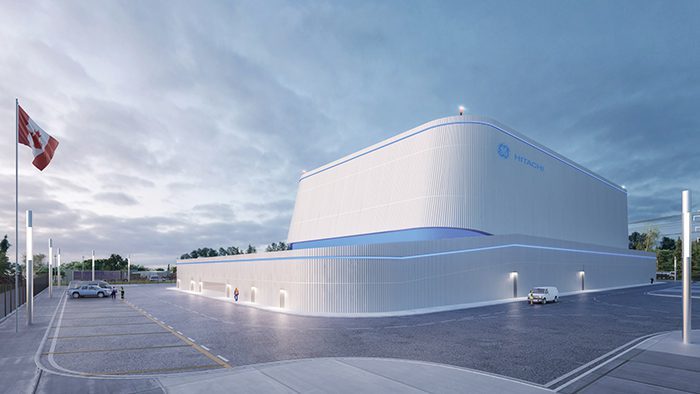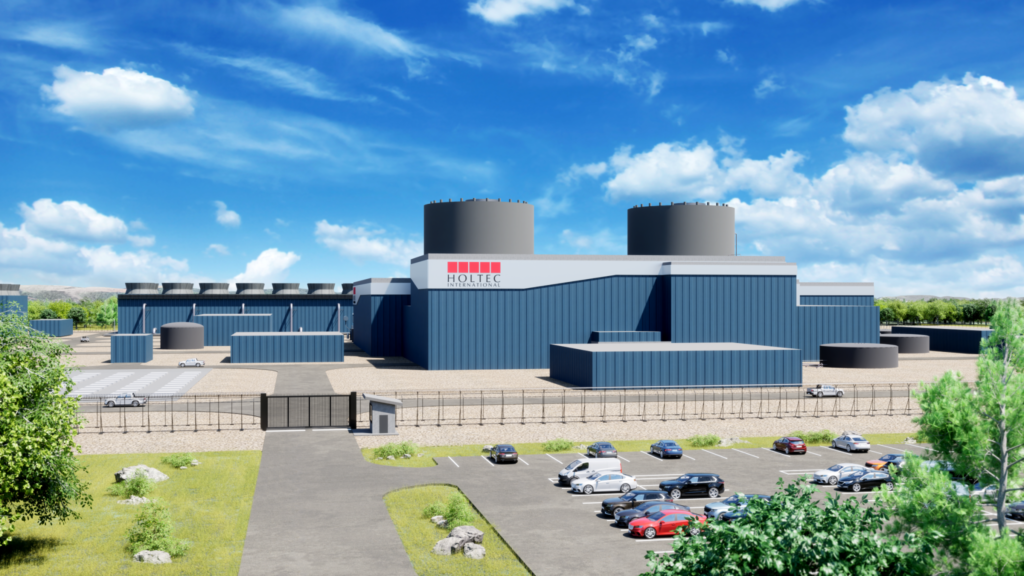UK Nuclear Recap: Major Funding for GEH's SMR and Sizewell C as Hinkley Point C Suffers New Hefty Delays
Over the past week, the UK government stepped up its nuclear agenda, doling out a £33.6 million grant under its Future Nuclear Enabling Fund to support GE Hitachi Nuclear Energy (GEH)’s BWRX-300 while also announcing a substantial £1.3 billion investment in the proposed 3.2-GW Sizewell C nuclear project. The developments, aimed at potentially tripling the UK’s nuclear capacity by 2050, arrive as EDF announced delays of up to three years and billions more of cost overruns at its Hinkley Point C project, highlighting the complexities and strategic shifts in the UK’s ambitious nuclear expansion plans.
UK Picks GE-Hitachi for Second Grant Under Future Nuclear Enabling Fund
The UK on Jan. 25 picked GE Hitachi Nuclear Energy (GEH) as its second grant selection under the UK Future Nuclear Enabling Fund (FNEF), a program aimed at boosting nuclear technology maturation as the country races to potentially triple its nuclear capacity to up to 24 GW by 2050.
GE Hitachi Nuclear Energy (GEH) will receive a £33.6 million ($42.7 million) FNEF grant from the Department for Energy Security & Net Zero (DESNZ) to further its BWRX-300 small modular reactor (SMR), a 300-MW boiling water reactor (BWR). “The application exceeded the quality thresholds across all 4 assessment criteria and successfully completed the Department’s due diligence and governance approvals processes,” the agency said on Thursday.
According to the UK government, GEH’s FNEF project includes its two-step Generic Design Assessment (GDA), a non-mandatory regulatory process overseen by the UK Office for Nuclear Regulation (ONR) and Environment Agency (EA) to ensure that new nuclear power plants meet UK safety and security standards.
GEH submitted its GDA entry application to the UK regulatory bodies in December 2022. On Thursday, the ONR and EA, along with Natural Resources Wales—an entity responsible for the management of Welsh natural resources—announced they had formally begun the GDA for the BWRX-300. The FNEF evaluation and selection “concluded that the design is ready to enter the GDA process,” they said.
The FNEF selection also kicks off “Enterprise Readiness” activities, including an “Advanced Manufacturing Plan” and “Operator Plan” for the BWRX-300. The activities are geared to ensure the design addresses investment risks associated with technological readiness.
GEH submitted the FNEF application with a team that includes engineering giant Jacobs, a multinational infrastructure construction company Laing O’Rourke, and UK nuclear specialist Cavendish Nuclear. Synthos Green Energy (SGE), a firm that holds exclusive rights for the deployment of a BWRX-300 fleet in Poland, was also part of the FNEF application team. Jacobs, notably, is supporting the GDA.
GEH also noted it is developing “a UK supply chain which includes a memorandum of understanding with Sheffield Forgemasters for a potential supply agreement for UK-sourced steel forgings in support of the deployment of BWRX-300 SMRs.”

UK’s First FNEF Selection Went to Holtec
GEH’s selection is the second of the FNEF, for which the UK has designated a combined £73.4 million. The FNEF’s first grant selection, announced on Dec. 7, 2023, went to Holtec Britain, Holtec International’s UK arm. The UK indicates a third potential applicant is shortlisted to receive a partial grant award for the remaining £9.75 million.
Holtec will receive £30.05 million ($38.1 million) under the FNEF. Like the BWRX-300, the selection clears ONR to begin the two-step GDA for Holtec’s SMR-300 design. Holtec has proposed a “large expansion” for the 300-MW pressurized water reactor (PWR) in the UK, including building a factory to build major mechanical SMR components. It has also proposed “other aligned areas of business (clean energy & defense)” that could support the deployment of more than 5 GW for the UK’s grid by 2050.
“It should be noted that SMR-300 is a PWR reactor technology based on existing standards in the US and UK and uses PWR fuel similar to that already used at Sizewell B and other new UK reactors under development, including Hinkley Point C,” Holtec noted in December. “This is reported to enable economic viability of fuel fabrication and back-end disposal of the fuel, supporting UK energy independence.”
In the U.S., Holtec is developing twin SMR-300 reactors to support the repowering of Palisades Nuclear Power Plant, a single-unit 800-MW reactor in Michigan that was taken offline in May 2022. Holtec acquired the plant in June 2022, and it has since laid out plans to refurbish the site for a potential restart by 2025. It plans to add the two Holtec SMR-300 units, targeting a commissioning date in mid-2030. It notes, however, that the timeframe will be subject to the U.S. Nuclear Regulatory Commission’s (NRC’s) regulatory reviews and oversight of our SMR. In December, the company said it plans to file a Construction Permit Application (CPA) for the twin SMR-300 units in 2026, “shortly after the existing Palisades plant returns to service.”

GEH, meanwhile, is already fielding several projects or prospects around the world. Ontario Power Generation (OPG) in December 2021 selected the BWRX-300 for its first SMR deployment at the Darlington Nuclear Facility in Ontario, which could be completed as early as 2028 (with an anticipated commercial start date in 2029). Other deployment prospects are brewing in Tennessee, Saskatchewan, Estonia, the Czech Republic, Sweden, and as POWER recently reported, in Alberta.
Billions More in Cost Overruns at Hinkley C Showcase Complexity of UK’s Multifaceted Nuclear Agenda
Both GEH and Holtec Britain recently cleared the UK’s shortlist of the country’s Small Modular Reactor (SMR) competition, a fast-track measure that could result in a government contract within the next 10 months as part of a strategy to deliver operational SMRs by the mid-2030s. Other contenders include EDF, NuScale Power, Rolls Royce SMR, and Westinghouse Electric Company UK.
The UK may issue a contract for a potential SMR project by the summer of 2024 with a strategy to deliver operational SMRs by the mid-2030s. The next phase of the competition will entail choosing successful technologies that could be ready to enable a final investment decision (FID) by 2029.
The efforts are outlined in great detail in the UK’s comprehensive civil nuclear roadmap, which was unveiled on Jan. 11. As POWER reported, the roadmap sets out a series of goals and actions that could enable the delivery of 3 GW to 7 GW every five years from 2030 to 2044, along with potential risks and hurdles. The report suggests the country’s most prominent challenges rest on siting and land usage, regulations, workforce development, and financing and funding models—factors that have historically posed hurdles to nuclear development.
Delays remain a prominent concern, and the UK’s only nuclear project currently under construction, the 3.2-GW Hinkley Point C in Somerset, southwest England, is already fielding risks. EDF, which is building Hinkley Point C’s twin EPR reactors on Jan. 23 said that a finalized review of the project led to a re-evaluation of schedule and costs. It suggests delays of up to three years, extending the in-service timeframe from 2027, as was recently anticipated, to 2031.
One scenario suggests Hinkley Point C Unit 1 could be operational in 2029, but the schedule will be based on a “target productivity for the electromechanical work, which action plans are being drawn up to achieve,” EDF explained. “A second scenario (base case), which assumes certain risks inherent in the ramp-up of the electromechanical work and the testing schedule do materialize, would see Unit 1 operational in 2030. Finally, given the complexity of the project, an unfavorable scenario assuming a further 12-month risk materializes could lead to Unit 1 being operational in 2031.”
Cost increases affiliated with the delay will also be exorbitant. Compared to original cost estimates of between £25 billion and £26 billion in 2015, EDF now estimates costs of completing the project will hover between £31 billion and £34 billion in 2015 values. Adjusted for inflation (using the Bank of England’s inflation calculator), that amounts to a cost estimate of between £40.98 billion ($52 billion) and £44.95 billion ($57 billion).
“The cost of civil engineering and the longer duration of the electromechanical phase (and its impact on other work) are the two main reasons for this cost revision,” EDF noted. “If the risk of an additional delay of 12 months mentioned above in the final scenario does materialize, it would result in an estimated additional cost of around £1 billion in 2015 values.”
In this video, Stuart Crooks, managing director at EDF’s 3.2-GW Hinkley Point C, provides an update on the new nuclear build, the UK’s first built after 1995. “Restarting the British new nuclear industry has been hard,” he notes. “We’ve had to build a new workforce, teach suppliers how to build nuclear, and like any other developer, change our design to meet British regulations. That means 7,000 design changes, 35% more steel, and 25% more concrete. Like other big infrastructure projects, we have found civil construction slower than we hoped and faced inflation, labor, and material shortages.” Courtesy: EDF
UK Injects $1.7B More Into Sizewell C
Earlier this week, the UK government announced £1.3 billion ($1.7 billion) additional investment in Sizewell C, a second 3.2-GW EPR nuclear project proposed in Suffolk, eastern England. “The largest funding package to date will allow early construction works to continue ahead of a final investment decision later this year,” it said. “Investing an additional £1.3 billion consolidates the government’s position as the majority shareholder in the project, reached in December 2023. It follows a £700 million funding pledge in November 2022 and a further £511 million agreed last summer.”
So far, the UK has committed £1.2 billion of investment to support the Sizewell C’s development, which began in 2012. The Civil Nuclear Roadmap suggests that the UK will make a final investment decision (FID) on the power plant by the end of the current Parliament (which culminates in December 2024). If approved, Sizewell C could begin operations in the mid-2030s.
The UK government reasons that as an above-ground replica of Hinkley Point C, Sizewell C “would benefit from the lessons learned and established supply chain of that project—benefits that are already being demonstrated between reactors 1 and 2 at [Hinkley Point C]—providing higher levels of maturity and de-risking the project.” In September 2023, notably, the government and EDF began a process to bring private equity investment into Sizewell C, using the newly established Regulated Asset Base (RAB) financing model for nuclear.
Combined, Hinkley Point C and Sizewell C could generate up to 14% of the UK’s power needs. However, the roadmap suggests the UK government is committed to also exploring another large-scale reactor. “This means the UK will look to deploy both SMRs and further large-scale nuclear in parallel over the next decade, providing the supply chain the certainty it needs to invest in skills and local communities,” it says. “We will set out timelines and process by the end of this Parliament, subject to a [Sizewell C] FID,” it says.
—Sonal Patel is a POWER senior associate editor (@sonalcpatel, @POWERmagazine).